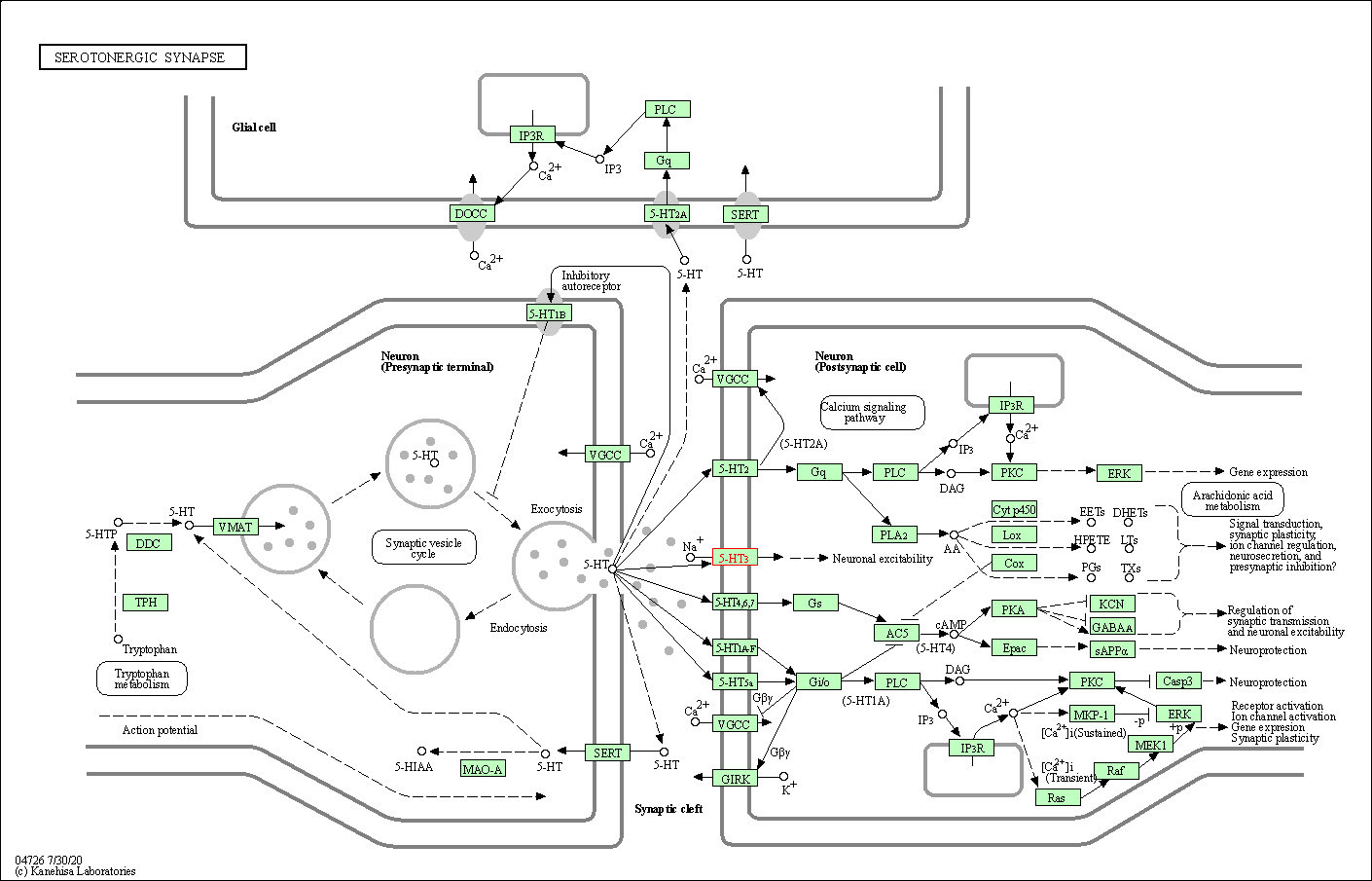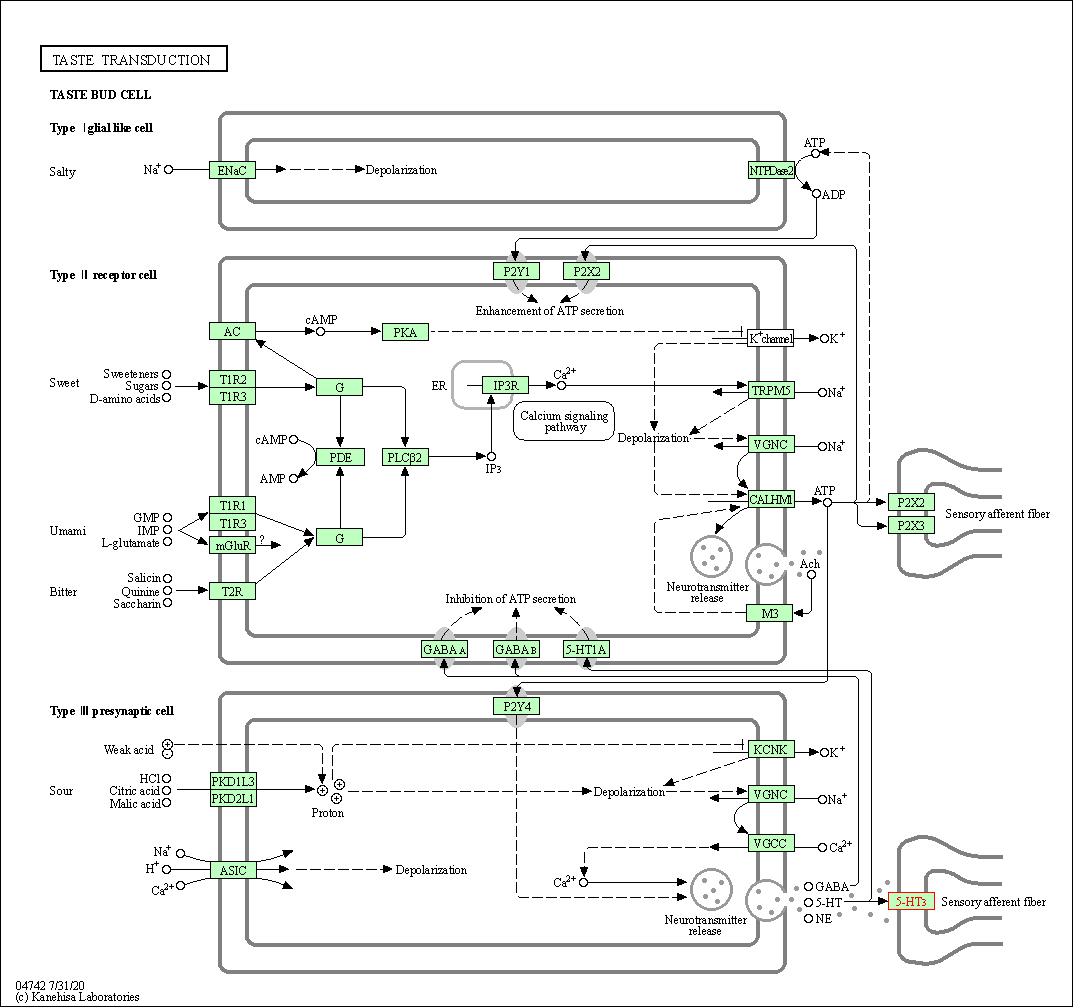Target Information
| Target General Information | Top | |||||
|---|---|---|---|---|---|---|
| Target ID |
T58940
(Former ID: TTDC00009)
|
|||||
| Target Name |
5-HT 3B receptor (HTR3B)
|
|||||
| Synonyms |
Serotonin receptor 3B; 5-hydroxytryptamine receptor 3B; 5-HT3B; 5-HT3-B; 5-HT-3B
Click to Show/Hide
|
|||||
| Gene Name |
HTR3B
|
|||||
| Target Type |
Discontinued target
|
[1] | ||||
| Function |
This is one of the several different receptors for 5-hydroxytryptamine (serotonin), a biogenic hormone that functions as a neurotransmitter, a hormone, and a mitogen. This receptor is a ligand-gated ion channel, which when activated causes fast, depolarizing responses. It is a cation-specific, but otherwise relatively nonselective, ion channel.
Click to Show/Hide
|
|||||
| BioChemical Class |
GPCR rhodopsin
|
|||||
| UniProt ID | ||||||
| Sequence |
MLSSVMAPLWACILVAAGILATDTHHPQDSALYHLSKQLLQKYHKEVRPVYNWTKATTVY
LDLFVHAILDVDAENQILKTSVWYQEVWNDEFLSWNSSMFDEIREISLPLSAIWAPDIII NEFVDIERYPDLPYVYVNSSGTIENYKPIQVVSACSLETYAFPFDVQNCSLTFKSILHTV EDVDLAFLRSPEDIQHDKKAFLNDSEWELLSVSSTYSILQSSAGGFAQIQFNVVMRRHPL VYVVSLLIPSIFLMLVDLGSFYLPPNCRARIVFKTSVLVGYTVFRVNMSNQVPRSVGSTP LIGHFFTICMAFLVLSLAKSIVLVKFLHDEQRGGQEQPFLCLRGDTDADRPRVEPRAQRA VVTESSLYGEHLAQPGTLKEVWSQLQSISNYLQTQDQTDQQEAEWLVLLSRFDRLLFQSY LFMLGIYTITLCSLWALWGGV Click to Show/Hide
|
|||||
| 3D Structure | Click to Show 3D Structure of This Target | AlphaFold | ||||
| Cell-based Target Expression Variations | Top | |||||
|---|---|---|---|---|---|---|
| Cell-based Target Expression Variations | ||||||
| Different Human System Profiles of Target | Top |
|---|---|
|
Human Similarity Proteins
of target is determined by comparing the sequence similarity of all human proteins with the target based on BLAST. The similarity proteins for a target are defined as the proteins with E-value < 0.005 and outside the protein families of the target.
A target that has fewer human similarity proteins outside its family is commonly regarded to possess a greater capacity to avoid undesired interactions and thus increase the possibility of finding successful drugs
(Brief Bioinform, 21: 649-662, 2020).
Human Pathway Affiliation
of target is determined by the life-essential pathways provided on KEGG database. The target-affiliated pathways were defined based on the following two criteria (a) the pathways of the studied target should be life-essential for both healthy individuals and patients, and (b) the studied target should occupy an upstream position in the pathways and therefore had the ability to regulate biological function.
Targets involved in a fewer pathways have greater likelihood to be successfully developed, while those associated with more human pathways increase the chance of undesirable interferences with other human processes
(Pharmacol Rev, 58: 259-279, 2006).
Human Similarity Proteins
Human Pathway Affiliation
|
|
|
There is no similarity protein (E value < 0.005) for this target
|


| KEGG Pathway | Pathway ID | Affiliated Target | Pathway Map |
|---|---|---|---|
| Serotonergic synapse | hsa04726 | Affiliated Target |

|
| Class: Organismal Systems => Nervous system | Pathway Hierarchy | ||
| Taste transduction | hsa04742 | Affiliated Target |

|
| Class: Organismal Systems => Sensory system | Pathway Hierarchy | ||
| Drug Property Profile of Target | Top | |
|---|---|---|
| (1) Molecular Weight (mw) based Drug Clustering | (2) Octanol/Water Partition Coefficient (xlogp) based Drug Clustering | |
|
|
||
| (3) Hydrogen Bond Donor Count (hbonddonor) based Drug Clustering | (4) Hydrogen Bond Acceptor Count (hbondacc) based Drug Clustering | |
|
|
||
| (5) Rotatable Bond Count (rotbonds) based Drug Clustering | (6) Topological Polar Surface Area (polararea) based Drug Clustering | |
|
|
||
| "RO5" indicates the cutoff set by lipinski's rule of five; "D123AB" colored in GREEN denotes the no violation of any cutoff in lipinski's rule of five; "D123AB" colored in PURPLE refers to the violation of only one cutoff in lipinski's rule of five; "D123AB" colored in BLACK represents the violation of more than one cutoffs in lipinski's rule of five | ||
| Target Profiles in Patients | Top | |||||
|---|---|---|---|---|---|---|
| Target Expression Profile (TEP) |
||||||
| Target Affiliated Biological Pathways | Top | |||||
|---|---|---|---|---|---|---|
| KEGG Pathway | [+] 1 KEGG Pathways | + | ||||
| 1 | Serotonergic synapse | |||||
| Panther Pathway | [+] 1 Panther Pathways | + | ||||
| 1 | 5HT3 type receptor mediated signaling pathway | |||||
| Reactome | [+] 1 Reactome Pathways | + | ||||
| 1 | Ligand-gated ion channel transport | |||||
| WikiPathways | [+] 1 WikiPathways | + | ||||
| 1 | Iron uptake and transport | |||||
| Target-Related Models and Studies | Top | |||||
|---|---|---|---|---|---|---|
| Target Validation | ||||||
| References | Top | |||||
|---|---|---|---|---|---|---|
| REF 1 | Zatosetron, a potent, selective, and long-acting 5HT3 receptor antagonist: synthesis and structure-activity relationships. J Med Chem. 1992 Jan 24;35(2):310-9. | |||||
| REF 2 | Pharmacological comparison of human homomeric 5-HT3A receptors versus heteromeric 5-HT3A/3B receptors. Neuropharmacology. 2001 Aug;41(2):282-4. | |||||
| REF 3 | Aromatic thiazole derivatives: structurally novel and selective serotonin-3 receptor antagonists. J Med Chem. 1990 Jan;33(1):13-6. | |||||
| REF 4 | Synthesis of 2-piperazinylbenzothiazole and 2-piperazinylbenzoxazole derivatives with 5-HT3 antagonist and 5-HT4 agonist properties. J Med Chem. 1994 Apr 29;37(9):1320-5. | |||||
| REF 5 | Novel potent and selective central 5-HT3 receptor ligands provided with different intrinsic efficacy. 2. Molecular basis of the intrinsic efficacy ... J Med Chem. 1999 May 6;42(9):1556-75. | |||||
| REF 6 | The 5-HT3B subunit is a major determinant of serotonin-receptor function. Nature. 1999 Jan 28;397(6717):359-63. | |||||
| REF 7 | Ginkgolide B and bilobalide block the pore of the 5-HT eceptor at a location that overlaps the picrotoxin binding site. Neuropharmacology. 2011 Feb-Mar;60(2-3):488-95. | |||||
| REF 8 | Synthesis and structure-affinity relationships of novel N-(1-ethyl-4-methylhexahydro-1,4-diazepin-6-yl)pyridine-3-carboxamides with potent serotoni... J Med Chem. 2003 Feb 27;46(5):702-15. | |||||
| REF 9 | Novel and highly potent 5-HT3 receptor agonists based on a pyrroloquinoxaline structure. J Med Chem. 1997 Oct 24;40(22):3670-8. | |||||
| REF 10 | Co-expression of the 5-HT(3B) subunit with the 5-HT(3A) receptor reduces alcohol sensitivity. Brain Res Mol Brain Res. 2005 Dec 14;142(2):146-50. | |||||
If You Find Any Error in Data or Bug in Web Service, Please Kindly Report It to Dr. Zhou and Dr. Zhang.

